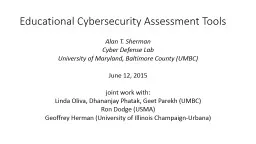PPT-Northrop Grumman Cybersecurity
Author : cheryl-pisano | Published Date : 2018-12-19
Research Consortium NGCRC 08 November 2018 Bharat Bhargava Purdue University Secure Intelligent Autonomous Systems with Cyber Attribution Technical Champions Paul
Presentation Embed Code
Download Presentation
Download Presentation The PPT/PDF document "Northrop Grumman Cybersecurity" is the property of its rightful owner. Permission is granted to download and print the materials on this website for personal, non-commercial use only, and to display it on your personal computer provided you do not modify the materials and that you retain all copyright notices contained in the materials. By downloading content from our website, you accept the terms of this agreement.
Northrop Grumman Cybersecurity: Transcript
Download Rules Of Document
"Northrop Grumman Cybersecurity"The content belongs to its owner. You may download and print it for personal use, without modification, and keep all copyright notices. By downloading, you agree to these terms.
Related Documents














